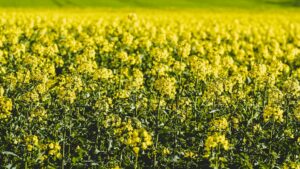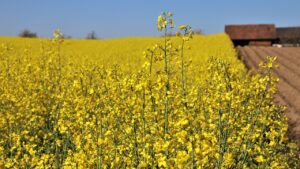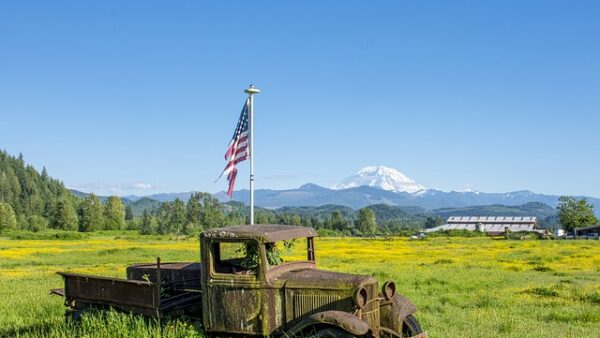Unlocking the secrets of the canola genome is yielding a plethora of exciting possibilities.
_x000D_
Developed through collaboration between scientists at AAFC, National Research Council Canada and the University of Manitoba in the 1970s, canola is now the most important oilseed crop in not only Canada, but also in Europe, Asia and Australia. It continues to be a mainstay of Canadian agriculture, contributing $19 billion annually to the national economy._x000D_
_x000D_
Unlocking the secrets of the canola genome has taken many years and involved the efforts of leading scientists from around the world, including Isobel Parkin, an Agriculture and Agri-Food Canada research scientist specializing in plant genomics based in Saskatoon, Sask._x000D_
_x000D_
Working in collaboration with domestic and international researchers, Parkin was part of the international team that recently deciphered the complex genome of Brassica napus, which is extensively cultivated as canola in Canada._x000D_
_x000D_
Parkin says the contribution of her research team at the AAFC Saskatoon Research Centre was essentially twofold. “We were helping with sequencing the progenitors of canola, and then also helping put this big jigsaw puzzle together.”_x000D_
_x000D_
Canola is also one of the most recent plant species, with a very unique origin. The first Brassica napus plants originated just a few thousand years ago from unintentional crosses between European cabbages and Asian turnips. Because all flowering plants originated from such events (but in most cases millions of years ago), the canola genome provides unique insight into the early formation of new species in plants._x000D_
_x000D_
Unlike many other plants, canola has retained almost all of the genes of its two parental species, likely as a result of breeding efforts. These multiple gene copies provide novel material for further adaptation of the crop. With more than 100,000 genes, canola contains one of the highest gene densities of any sequenced organism; humans, in comparison, have fewer than 30,000 genes in their genetic makeup._x000D_
_x000D_
Unique Challenge_x000D_
_x000D_
Parkin says the plant’s multiple gene copies did provide a unique challenge for researchers piecing the canola sequence together._x000D_
_x000D_
“It means that effectively for every single part of your genome you’ve got another piece of it that is almost exactly the same. You have very similar bits of the genome that you’re trying to separate,” she explains._x000D_
_x000D_
“If it’s like a jigsaw puzzle, you’ve got an awful lot of blue sky and its very difficult to work out which bit of sky goes where, especially when they look so similar to each other.”_x000D_
_x000D_
According to Parkin, the project produced groundbreaking knowledge about the origins of the species that will help provide researchers with unique evolutionary insights and new tools for plant breeders._x000D_
_x000D_
“The genome sequence of canola has uncovered the complexities which define this important crop. This knowledge will prove invaluable for making future agronomic improvements,” Parkin says._x000D_
_x000D_
The insights gained through the canola genome sequencing project will not only enable plant breeders to be much more specific and focused in terms of the traits they’re looking to develop, she adds, but they will now be able to perform this work in much less time._x000D_
_x000D_
“You can follow things like fatty acid profiles in the lab, so you don’t actually have to put thousands of lines in the field and then do the quality analysis after the fact.”_x000D_
_x000D_
According to Parkin, knowledge gained through the canola genome sequencing project will also help address one of the main challenges facing canola breeders._x000D_
_x000D_
“The limitations in canola breeding at the moment are really the fact that there’s been a reduction in the variation that’s been used,” she explains. “There’s been a fair amount of selection and breeding particularly for quality traits… but in doing that [breeders] tend to select for the same regions over and over again, so you reduce your variation in your germplasm.”_x000D_
_x000D_
Parkin says having a map of the canola gene sequence will enable scientists to precisely target those areas of the genome where variation would be best introduced._x000D_
_x000D_
Habibur Rahman, a canola breeder at the University of Alberta, agrees that increasing the diversity in breeding materials is vital._x000D_
_x000D_
“Research has shown that genetic diversity in canola is low, and this needs to be broadened, especially for breeding improvements … and for developing good hybrid cultivars,” he says._x000D_
“Research has shown that genetic diversity in canola is low.”_x000D_
_x000D_
— Habibur Rahman
_x000D_
Producing Better Hybrids_x000D_
_x000D_
Much of Rahman’s current work is focused on broadening genetic diversity in canola through the introduction of new genes and alleles from different brassica species and germplasms. The goal, he says, is to broaden the genetic base of Canadian canola over the long term and to create good parents for producing better hybrids._x000D_
_x000D_
Rahman, who uses conventional breeding methods as well as molecular markers and other genetic techniques, is also helping lead the fight against clubroot, an increasing threat for canola producers across the Prairies._x000D_
_x000D_
Rahman says the integration of clubroot resistance into canola and the development of clubroom-resistant parent lines for hybrids is another important aspect of his research program at the University of Alberta._x000D_
_x000D_
Back in 2012, the university began collaborating with Crop Production Services (a subsidiary of Agrium Inc.) in a private-public initiative aimed at delivering clubroot resistance genes to the market in competitive canola hybrids._x000D_
_x000D_
In this way, Rahman helped develop CPS’s multigenic clubroot-resistant canola variety called PV 580 GC, which was officially registered in October 2015 and is purported to have high levels of resistance to multiple clubroot pathotypes. That’s because the new Genuity Roundup Ready canola hybrid carries two clubroot resistance genes, unlike “most clubroot resistance cultivars in the market that carry a single resistance gene,” Rahman says._x000D_
_x000D_
In a media release announcing the PV 580 GC launch, Ryan McCann, director of seed for CPS Canada, said the company’s R&D team has invested heavily in discovering and breeding new hybrids that will provide canola growers with increased levels of clubroot resistance. “Our hybrid program includes incorporation and testing of novel genes that offer a high level of resistance to multiple clubroot pathotypes,” noted McCann._x000D_
_x000D_
Curtis Rempel, vice-president of the Canadian Canola Council, sees partnerships between private industry and public institutions (like the canola initiative involving CPS and the University of Alberta) as a strong trend in canola breeding in Canada.












